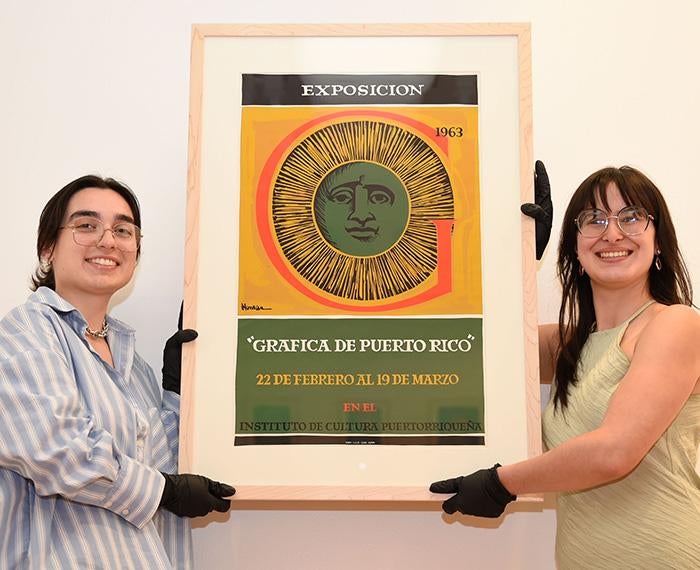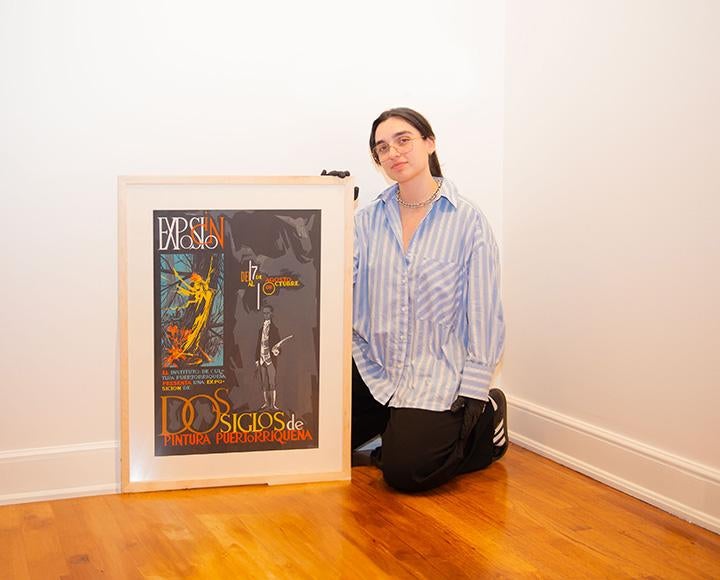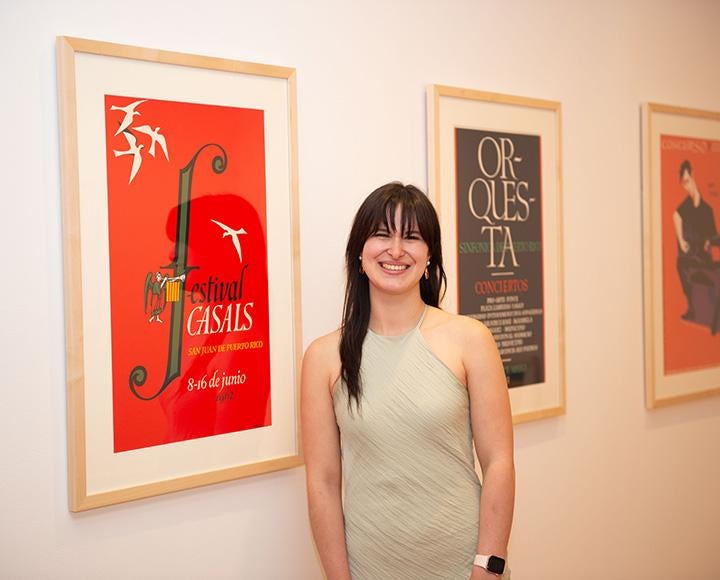
Subscribe to Pittwire Today
Get the most interesting and important stories from the University of Pittsburgh.These University Art Gallery exhibits spotlight Latinx and Caribbean identities

Camila Aguayo says working on Pitt’s new “Printing Culture: Gráfica de Puerto Rico, 1958-63” exhibit deepened both her passion for history and her own Puerto Rican heritage.
The student-curated exhibit, which opened on Oct. 12, is one of three in the University Art Gallery’s (UAG) fall series celebrating Latinx and Caribbean identities and draws from the University’s Walter and Martha Leuba Collection. Two others in the series launched in September: “Agua Firme,” an installation from sisters iliana emilia and Scherezade García, and the traveling “The Kingdom of This World, Reimagined,” which is shared with Carlow University. UAG director Sylvia Rhor Samaniego said the latter spotlights Black, Latinx and Haitian artists who reflected on the Haitian revolution. Other displays and objects lessons will also be featured throughout the semester.
During her sophomore year, Aguayo (A&S ’23), a marketing and art history major, took a course on sculptures with Department of History of Art and Architecture teaching professor and assistant chair Gretchen Bender, who she said helped her “realize we’re a cultural mélange of everywhere in the world” and to fall “in love with the discipline.”
The experience encouraged her to apply for the Frederick Honors College Brackenridge Fellowship. As a fellow, she focused on Puerto Rican art, reading journals from 18th-century Spanish friars and other prominent Latinx figures in the industry who, she said, are seldom discussed in academia.
“I was able to learn so much of my own culture,” Aguayo said.
After the fellowship, she took a museum studies curatorial development course, during which students collaborated with UAG in phase one of a project using original Puerto Rican silk screen posters from the Instituto de Cultura Puertorriqueña (ICP). Research entailed calling Puerto Rican museums and universities.
“My dad has a silk screen, they are everywhere back home,” said Aguayo. The accessible medium was used throughout the 20th century to advocate for social justice and Puerto Rican identity separate from American or Spanish cultures. Prior to this project, Aguayo said, she was unfamiliar with the ICP’s use of the posters — produced by the thousands, along with books, films and events to educate the masses and instill pride.
Phase two launched this semester in the exhibition presentation course, where students wrote captions and descriptions for the artwork. By this time, Aguayo continued work on the project not as an undergraduate but as a Hot Metal Bridge fellow. The post-baccalaureate program aids talented students from groups underrepresented in their discipline and bridges the gap between undergraduate degrees and graduate training programs. It’s made a significant difference for her.
“The program allows me to see what I can do with my interests in the future and explore what it means to be Puerto Rican,” she said.


Irene Castillo, a fellow San Juan native, arrived in Pittsburgh in 2020. She met Aguayo through Bender, though both also credited Carnegie Museum of Art Curatorial Assistant Alyssa Velazquez for their collaborations, including establishing the Puerto Rican Student Association and working on the exhibit.
Despite praising Pittsburgh’s celebration of Roberto Clemente’s legacy, Castillo, a junior studying history of art and architecture with a museum studies minor, said she experiences isolation in small ways, like when she’s on the phone, walking between classes and speaking Spanish.
“People turn and are surprised,” she said. “It’s not a microaggression, but it’s not normal for them.”
Working on phase two of the exhibit enabled her to meet people with similar lived experiences and have transparent conversations with non-Latinx classmates.
“It became bigger than just the academics of art,” she added.
Castillo and Aguayo both hope the series will increase curiosity and knowledge about Latin American cultures. Beyond the exhibit, Aguayo said she’s been inspired to pursue more curatorial work in Pittsburgh and back home.
“I want to create exhibitions and spaces where people can see that European art is not the epitome of art,” she said. “How the silk screen changed the community that engaged with it, that’s what I want to do and bring to the forefront.” Pitt, she added, provided her with the tools and community to see this as a possibility.
“Pitt is an amazing, research-based university. I don’t know if I would have been able to do research and art history to the extent I have here at other universities.”
— Kara Henderson, photography by Johnathan Wright

